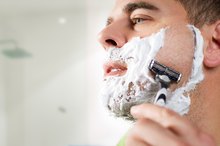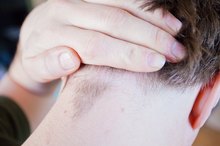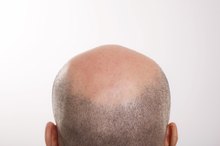How to Get Rid of Ingrown Hairs on the Neck
It isn't uncommon to suffer from ingrown hairs on the neck. Shaving can cut the hairs on the neck so short that they curl back and grow into the skin. This causes an inflammatory response, resulting in a red papule, also known as a razor bump. Men with curlier hair tend to suffer from this condition more than others, but anyone can develop razor bumps after shaving, waxing or plucking. Once an ingrown hair develops, there are methods to get rid of it.
Try dislodging the ingrown portion of the hair. Using a needle or a tweezers, gently guide the embedded tip out of the skin. This works best on ingrown hairs visible to the eye. Swab the area with alcohol after the tip is free to avoid infection.
Removing an Ingrown Hair on the Face
Learn More
Massage the papule with a toothbrush. Massaging the neck with a soft-bristled toothbrush can release the tips of hairs growing into the skin, according to the American Academy of Dermatology 1. Inflammation should dissipate soon after the hair is no longer growing into the skin.
Apply a topical medication directly onto the papules. The American Osteopathic College of Dermatology endorses a few different prescriptions, including retinoids, corticosteroids and glycolic acids 1. By using these medicated creams each day, you're killing bacteria, removing dead skin and reducing inflammation, which helps to get rid of razor bumps.
How to Treat Ingrown Hairs on the Scalp
Learn More
Ask your dermatologist about a prescription antibiotic. Some ingrown hairs may need to be treated with an oral or topical antibiotic. This can speed healing, which helps to reduce the razor bumps.
Let the hair on your neck grow. This method takes the most time to provide results but is considered the most effective by the American Osteopathic College of Dermatology 1. It can take a full month to see results.
Tips
Avoid ingrown hairs by preparing the skin and beard before shaving. Shaving gels and wet skin make it easier to shear hair and make the hair less likely to curl back. Always clean the razor after each stroke and limit strokes to one pass per area of skin. It's also important to shave in the direction of your hair growth.
Switch to an electric razor if blades cause razor bumps. Depilatories may also be a solution, but they can irritate sensitive skin types.
Chronic ingrown hairs can see an improvement with permanent hair removal.
Related Articles
References
- American Academy of Dermatology: Skin of Color
- Seventeen Magazine: Get Fuzz-Free!
- MedlinePlus. Acne.
- Cleveland Clinic. Ingrown hair. Updated February 28, 2018.
- Merck Manuals. Ingrown beard hairs. Updated October 2019.
- Cleveland Clinic. Ingrown hair: Management and treatment. Updated February 28, 2018.
- Ogunbiyi A. Pseudofolliculitis barbae; current treatment options. Clin Cosmet Investig Dermatol. 2019;12:241-247. doi:10.2147/CCID.S149250
- MedlinePlus. Folliculitis. Updated October 8, 2018.
- Zaenglein AL, Pathy AL, Schlosser BJ, Alikhan A, Baldwin HE, et. al. Guidelines of care for the management of acne vulgaris. Journal of the American Academy of Dermatology. 2016; 74(5): 945-73. doi:10.1016/j.jaad.2015.12.037
Writer Bio
Based in Minneapolis, Minn., Dana Severson has been writing marketing materials for small-to-mid-sized businesses since 2005. Prior to this, Severson worked as a manager of business development for a marketing company, developing targeted marketing campaigns for Big G, Betty Crocker and Pillsbury, among others.









